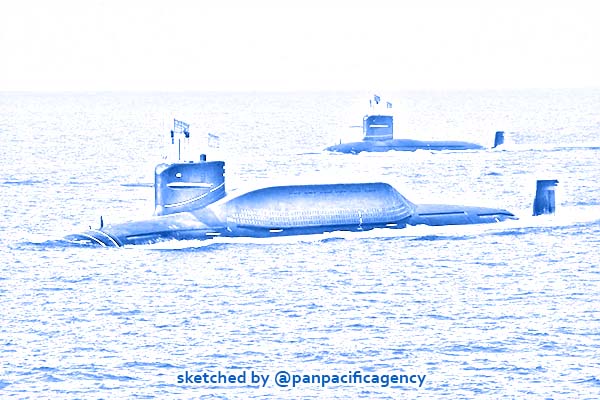New submarine or SLBMs likely next options for N. Korea: Experts

Two upgraded Type 094A nuclear submarines have gone into service in China. Photo: Reuters. Sketched by the Pan Pacific Agency.
SEOUL, May 25, 2020, Yonhap. The most probable step North Korea may take as a way to bolster nuclear capabilities would be launching a new submarine and submarine-launched ballistic missile (SLBM), though the regime is expected to walk on a tightrope ahead of the U.S. presidential election, experts said Monday, Yonhap reported.
After a weekslong absence from public view, North Korean leader Kim Jong-un convened a meeting of the Central Military Commission of the ruling Worker’s Party and discussed “new policies for further increasing the nuclear war deterrence,” the North’s official Korean Central News Agency reported Sunday.
The announcement drew fresh attention to a warning that the North issued at the end of last year that it will show off a “new strategic weapon” and could take “shocking actual action” amid stalled nuclear talks with the United States.
New intercontinental ballistic missiles with greater ranges, submarine-launched ballistic missiles (SLBMs) or submarines capable of firing SLBMs have been cited as possible new strategic weapons that the communist nation could show off.
South Korean intelligence authorities said they have been closely monitoring the North’s activities regarding preparations for the launching of a new submarine it first unveiled in July 2019.
The submarine, believed to be a 3,000-ton one, is capable of carrying three SLBMs and to have been under construction at its naval base in Sinpo on its east coast.
“It seems almost ready to be deployed,” a military source said. “We are closely watching when the North will hold a launching ceremony.”
Earlier this month, Seoul’s National Intelligence Service noted that 2,000-ton Gorae-class submarines and underwater missile ejection equipment have been detected at the Sinpo shipyard.
Currently, North Korea is believed to have 70 subs, including some 20 1,800-ton Romeo class ones. But most of them were known to be outdated and unfit for operations beyond coastal waters.
North Korea could also conduct additional tests of its newest SLBM, the Pukguksong-3, following the first test-launch in October 2019 off the east coast near Wonsan.
Classified as a medium-range missile, it is believed to be an upgraded version of the Pukguksong-1 missile. During the October test, the missile flew around 450 kilometers at a maximum altitude of about 910 km, according to the Joint Chiefs of Staff (JCS).
Along with nuclear-capable bombers and intercontinental ballistic missiles (ICBMs), the SLBM completes the strategic nuclear arsenal.
SLBMs, in general, have a lower accuracy rate than ICBMs, and can carry smaller nuclear warheads. But SLBMs can be employed effectively to launch a sudden nuclear retaliation attack against soft targets if North Korea faces a “first strike” from enemy forces.
According to the South’s intelligence authorities, North Korea developed the two Pukguksong-type missiles and their flight ranges reach around 1,300 km.
“It would pose threats not only to the regional but the global security, as the missiles launched from underwater are hard to detect. It is likely designed to be launched from canisters so that it can be easily transported,” said Shin Jong-woo, a senior analyst at the Korea Defense Security Forum in Seoul.
During the key party meeting, the North Korean leader also promoted Ri Pyong-chol, who is in charge of building nuclear weapons and missiles, to vice chairman of the commission. Pak Jong-chon, chief of the General Staff of the North’s Korean People’s Army in charge of artillery forces, was also promoted to vice marshal.
“Their promotion indicates that Kim will continue to expand the country’s nuclear and missile capabilities amid stalled denuclearization talks with the U.S.,” Shin added.
The latest push for nuclear capabilities, however, appears more to add pressure on the U.S. to take concrete steps to move forward the deadlocked dialogue, and to tighten discipline among its own military organizations, rather than warning about imminent provocative moves, according to experts.
“North Korea seems to have already deployed or to deploy soon new short-range missiles unveiled last year, and it is expected to maximize those assets as a leverage for some time rather than crossing a red line,” said Hong Min, a researcher of the Korea Institute for National Unification.
Since the collapse of negotiations on its nuclear weapons program with the U.S. early last year, North Korea has shown off several new types of missiles and carried out major weapons tests, mostly involving short-range projectiles.
Earlier this year, Pyongyang warned of a “new strategic weapon” and a “shocking actual action,” but it stopped short of launching an intercontinental ballistic missile.